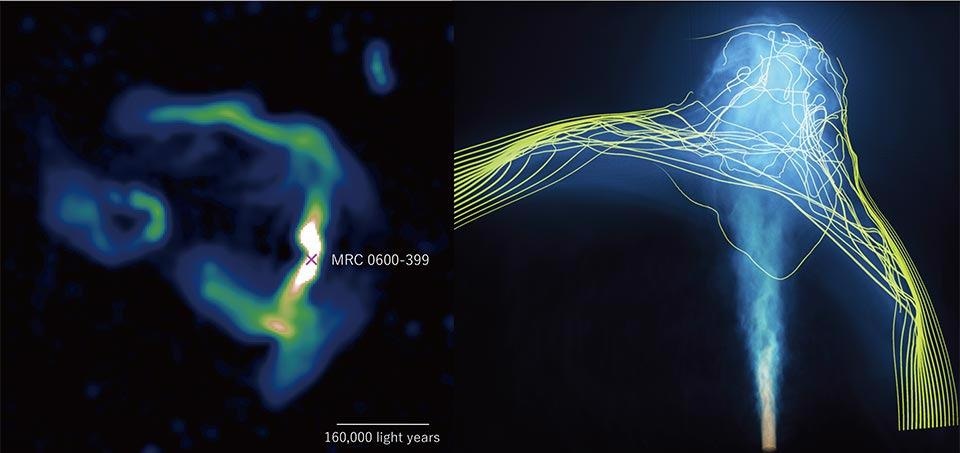May 6 2021
New simulations and observations have revealed that high energy particle jets produced from the central giant black hole in the brightest galaxy located in clusters of galaxies can be utilized to plot the structure of imperceptible inter-cluster magnetic fields.
 The bent jet structures emitted from MRC 0600-399 as observed by the MeerKAT radio telescope (left) are well reproduced by the simulation conducted on ATERUI II (right). The nearby galaxy B visible in the left part of the MeerKAT image is not affecting the jet and has been excluded in the simulation. Image Credit: Chibueze, Sakemi, Ohmura, et al. (MeerKAT image); Takumi Ohmura, Mami Machida, Hirotaka Nakayama, 4D2U Project, NAOJ (ATERUI II image)).
The bent jet structures emitted from MRC 0600-399 as observed by the MeerKAT radio telescope (left) are well reproduced by the simulation conducted on ATERUI II (right). The nearby galaxy B visible in the left part of the MeerKAT image is not affecting the jet and has been excluded in the simulation. Image Credit: Chibueze, Sakemi, Ohmura, et al. (MeerKAT image); Takumi Ohmura, Mami Machida, Hirotaka Nakayama, 4D2U Project, NAOJ (ATERUI II image)).
The new results offer astronomers an innovative tool for studying formerly unknown features of galaxy clusters.
When galaxy clusters expand via collisions with the surrounding matter, they emit bow shocks and wakes within their dilute plasma. The movement of plasma triggered by such activities can drape layers of intra-cluster magnetic fields, creating virtual walls of magnetic force.
But such magnetic layers can only be visualized indirectly when some object interacts with these layers. Since it is hard to detect these interactions, the nature of intra-cluster magnetic fields is yet to be fully understood. Hence, there is an urgent need to develop a new method to plot and define the magnetic layers.
An international group of astronomers, including Haruka Sakemi, a graduate student from Kyushu University (currently a research fellow from the National Astronomical Observatory of Japan, NAOJ), utilized the MeerKAT radio telescope deployed in the Northern Karoo desert of South Africa to visualize a bright galaxy located in the merging galaxy cluster Abell 3376, called MRC 0600-399.
MRC 0600-399 is situated over 600 million light-years away in the direction of the constellation Columba and is known to have unique jet structures that are bent to 90° angles.
Former X-ray observations had demonstrated that the MRC 0600-399 galaxy represents the core of a sub-cluster entering the main galaxy cluster. This indicates the existence of powerful magnetic layers at the edge between the sub and main clusters.
Such aspects make MRC 0600-399 the perfect platform to study the interactions between powerful magnetic layers and jets.
The observations made by the MeerKAT radio telescope uncovered unparalleled details of the jets and, most significantly, the faint 'double-scythe' structure that extends in the reverse direction from the bend points and produces a 'T' shape.
These latest findings demonstrate that similar to a jet of water striking a glass pane, this is a highly random collision. Specialized computer simulations are needed to describe the visualized jet morphology and potential configurations of the magnetic field.
Takumi Ohmura, a graduate student from Kyushu University (currently a research fellow from the Institute for Cosmic-Ray Research, ICRR, at the University of Tokyo), and the research team conducted simulations on NAOJ’s supercomputer ATERUI II—the world’s most robust computer developed for astronomical calculations.
These simulations considered an arch-like powerful magnetic field, ignoring disordered details, such as turbulence and the movement of the galaxy.
This basic model offers an excellent match to the observations, denoting that the magnetic pattern employed in the simulation mirrors the actual structure and intensity of the magnetic field around the MRC 0600-399 galaxy.
More significantly, the model shows that the simulations can effectively represent the fundamental physics so that they can be applied to other objects to define more intricate magnetic field structures in the galaxy clusters.
This offers astronomers a new means to interpret the magnetized universe and also a tool to examine the higher-quality information from upcoming radio observatories, such as the Square Kilometre Array (SKA).
ジェットと銀河団磁場の相互作用のシミュレーション
Simulation of the Interaction Between a Jet and the Magnetic Field of a Galaxy Cluster. Movie of the interaction between a jet and the magnetic field of a galaxy cluster, as simulated by ATERUI II. The color of the jet represents the velocity of the gas. The higher velocity part of the jet is shown in orange, and the slower part is shown in blue. The yellow lines represent the magnetic field lines. In the last scene, the intensity of electromagnetic radiation predicted by the simulation is shown in yellow. Video Credit: Takumi Ohmura, Mami Machida, Hirotaka Nakayama, 4D2U Project, NAOJ).
Journal Reference:
Chibueze, J. O., et al. (2021) Jets from MRC 0600-399 bent by magnetic fields in the cluster Abell 3376. Nature. doi.org/10.1038/s41586-021-03434-1.